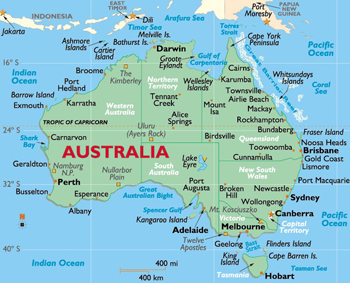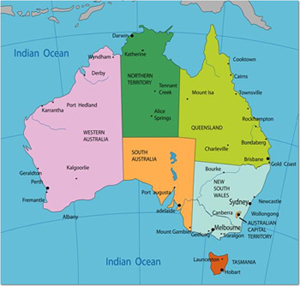Australia in Brief

It is estimated that Aborigines have occupied Australia for up to 60,000 years, giving them the longest continuous cultural history in the world. They originally lived as family tribes with many different languages and traditions. Fishermen from Indonesia and Papua New Guinea had been trading with Aborigines on the north coast long before the continent was formally discovered by European explorers in the 1600s.
Australia was originally called New Holland, as the Dutch first explored it, but it was the British who took the land as their own in 1788 - mostly as a place to send criminals. The British overtook the land and the native population of Aborigines suffered terribly. Many tribes no longer exist.
The population grew from a colony of criminals ("convicts") to farmers, entrepreneurs and other free settlers. Australia established its own system of unified government in 1901 and is still a part of the British Commonwealth today (the Queen of England is also the Queen of Australia).
During the gold rush in the 1850s, and after World War II, Australia took in large numbers of immigrants from Europe and Asia. This established great cultural diversity in Australia and today four out of 10 Australians are immigrants or children of immigrants.
TopGeography

Australia's 7,686,850 square kilometers (2,967,909 sq. mi) landmass is on the Indo-Australian Plate. Surrounded by the Indian, Southern and Pacific oceans, Australia is separated from Asia by the Arafura and Timor seas. Australia has a total 25,760 kilometers (16,007 mi) of coastline and claims an extensive Exclusive Economic Zone of 8,148,250 square kilometers (3,146,057 sq. mi). This exclusive economic zone does not include the Australian Antarctic Territory. The Great Barrier Reef, the world's largest coral reef, lies a short distance off the north-east coast and extends for over 2,000 kilometers (1,250 mi). The world's largest monolith, Mount Augustus, is located in Western Australia. At 2,228 metes (7,310 ft), Mount Kosciuszko on the Great Dividing Range is the highest mountain on the Australian mainland, although Mawson Peak on the remote Australian territory of Heard Island is taller at 2,745 metes (9,006 ft).
By far the largest part of Australia is desert or semi-arid. Australia is the driest inhabited continent, the flattest, and has the oldest and least fertile soils. Only the south-east and south-west corners of the continent have a temperate climate. The majority of the population lives along the temperate south-eastern coastline. The northern part of the country, with a tropical climate, has a vegetation consisting of rainforest, woodland, grassland, mangrove swamps and desert. Climate is highly influenced by ocean currents, including the El Niqo southern oscillation, which is correlated with periodic drought, and the seasonal tropical low pressure system that produces cyclones in northern Australia.
TopEconomy

Australia has a prosperous, Western-style mixed economy, with a per capita GDP slightly higher than the UK, Germany and France in terms of purchasing power parity. The country was ranked third in the United Nations' 2005 Human Development Index and sixth in The Economist worldwide quality-of-life index 2005. In recent years, the Australian economy has been resilient in the face of global economic downturn. Rising output in the domestic economy has been offsetting the global slump, and business and consumer confidence remains robust. Current areas of concern to some economists include Australia's high current account deficit and also the high levels of net foreign debt owed by the private sector.
Traditionally, the absence of an export oriented manufacturing industry has been considered a key weakness of the Australian economy. More recently, rising prices for Australia's commodity exports and increasing tourism has to some extent alleviated this criticism. Nevertheless, Australia has developed the world's third largest current account deficit in absolute terms (in relative terms over 7% of GDP). This has been considered problematic by some economists, especially as it has coincided with high prices for Australia's exports and low interest rates which keeps the cost of servicing the foreign debt unusually low.
The Australian economy has been performing nominally better than other economies of the OECD and has supported economic growth for 16 consecutive years. According to the Reserve Bank of Australia, Australian per capita GDP growth is higher than that of New Zealand, US, Canada and The Netherlands. The past performance of the Australian economy has been heavily influenced by US, Japanese and Chinese economic growth.
TopClimate

Australia is a continent that experiences a variety of climates due to its size. The weather can range from below zero temperatures in the Snowy Mountains to intolerable heat in the north-west. It is considered to be one of the driest continents on earth.
The temperate south has cool, wet winters and warm, dry summers. In the north, a tropical climate prevails with a warm, dry season and a hot, wet season. The extreme north-west experiences the ends of the monsoon systems, while the mountains of the south-east attract seasonal snow to form the Alpine snowfields. The temperatures vary from an average 30 degrees C in midsummer in the Red Centrex, to an average of 6 degrees C in the highlands in winter.
The inland deserts can remain totally dry for years whilst rains can produce floods.
Being in the Southern Hemisphere its seasons are in reverse to Europe and America. The ideal time to visit the north, particularly the Northern Territory's Kakadu National Park is early in the dry season (around May.) The Dry Season, April - October, is also a good time to visit northern Queensland's beaches and rain forests. You can swim off the coast without fear of dangerous stinging box jellyfish, which infest ocean waters between November and March. In the rain forests, heat and humidity are lower than later in the year and crocodile viewing is at its prime, as the creatures tend to bask on the riverbanks rather than submerge in the colder water.
TopUnderstanding Australians
Australians can be informal and casual in situations and they do not have many strict customs. they speak what they think and expect you to not be offended and do the same. If you are not invited in a conversation or activity, that is because they expect and welcome you to join in on your own.
TopEducation

School attendance is compulsory throughout Australia between the ages of 6-15 years (16 years in South Australia and Tasmania, and 17 years in Western Australia), contributing to an adult literacy rate that is assumed to be 99%. Government grants have supported the establishment of Australia's 38 universities, and although several private universities have been established, the majority receive government funding. There is a state-based system of vocational training colleges, known as TAFE Institutes, and many trades conduct apprenticeships for training new trades people. Approximately 58% of Australians between the ages of 25 and 64 have vocational or tertiary qualifications[19] and the tertiary graduation rate of 49% is highest of OECD countries. The ratio of international to local students in tertiary education in Australia is the highest in OECD countries.
TopStates and Territories

Australia consists of Six states and Two major mainland territories.
States
- New South Wales
- Queensland
- South Australia
- Tasmania
- Victoria
- Western Australia
Territories
- Northern Territory
- Australian Capital Territory
In most respects, the territories function similarly to the states, but the Commonwealth Parliament can override any legislation of their parliaments. By contrast, federal legislation overrides state legislation only with respect to certain areas as set out in Section 51 of the Constitution; all residual legislative powers are retained by the state parliaments, including powers over hospitals, education, police, the judiciary, roads, public transport and local government.
Each state and territory has its own legislature. The lower house is known as the Legislative Assembly (House of Assembly in South Australia and Tasmania) and the upper house is known as the Legislative Council. The heads of the governments in each state and territory are called premiers and chief ministers, respectively. The Queen is represented in each state by a governor; an administrator in the Northern Territory, and the Governor-General in the ACT, have analogous roles.
In the minor territories the federal government administers a separate area within New South Wales, the Jervis Bay Territory, as a naval base and sea port for the national capital. In addition Australia has the following, inhabited, external territories: Norfolk Island, Christmas Island, Cocos (Keeling) Islands, and several largely uninhabited external territories: Ashmore and Cartier Islands, Coral Sea Islands, Heard Island and McDonald Islands and the Australian Antarctic Territory.
Top
 +1(416) 653-8938
+1(416) 653-8938 +973 3932-4187
+973 3932-4187